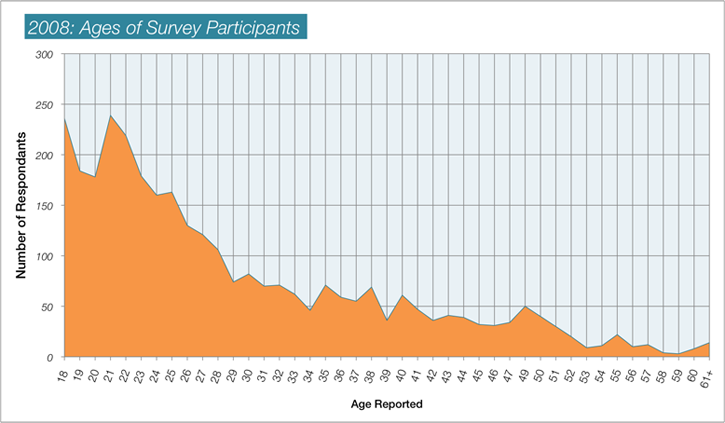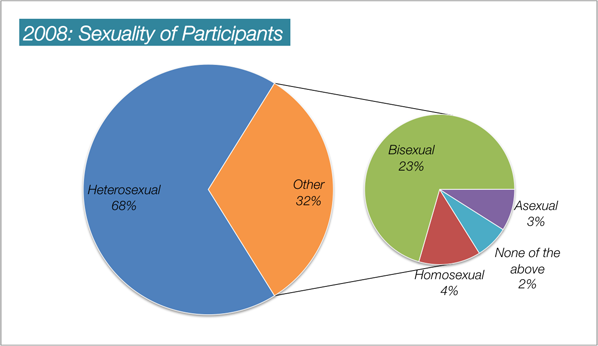The Participants
Demographic Information
For many years, it has been stated that the people who enjoy fan fiction are typically female, straight, single, and socially isolated. (Not coincidentally, many of these same stereotypes are attached to readers of commercial romance too.) With so many individuals growing up with internet access today and, accordingly, growing up with easier access to fan fiction, perhaps some of these dustier stereotypes about fans are finally starting to lose their hold on people's imaginations.
In order to get a sense of who was participating in the 2008 survey, the participants were asked for some general demographic information. At the time, I wanted to get a sense of the mix of fans taking the survey. Let's look at how these fans described themselves in 2008. Then I'd like to get your thoughts on the collection of fan demographics and the impulse to type fan fiction readers and writers.
Ages
First, in 2008 the participants skewed younger. The survey was only open to participants 18 or older, but the vast majority of survey participants were under thirty years of age. These numbers may also imply that there is significant participation in fan culture from individuals younger than 18. However, since younger fans were excluded from participating, these fans and their reading practices are not represented by the 2008 survey results.


Gender & Sexuality
The vast majority of fans participating in the survey (96%) identified as female. Many participants identified as heterosexual (68%), but a significant portion of participants (32%) identified as non-heterosexual, including the 23% of participants that identified themselves as bisexual. That's roughly a third of participants identifying as something other than straight.
In older discussions of fan cultures, it has often been assumed that fan fiction is primarily produced by straight women. Some have also speculated that, given the popularity of slash fan fiction, it might be problematic for straight female readers to be disinterested in reading romantic stories about straight women. For quite some time, many individuals in fan culture have been pushing back against these arguments. For example, identifying fan culture as female and straight ignores the many queer members of fan cultures. Also, why should the more "appropriate" character for female readers to identify with be female? Why does a reader need to have a literal insert within romantic and/or sexual content for it to be a "healthy" form of pleasure? These are just some of the ongoing questions being debated regarding the prevalence of slash in fan fiction.

As social awareness of and acceptance for queer, trans, and gender-queer identities increases, past assumptions regarding slash readers and the general demographic make-up of fan communities require serious reconsideration. I suspect that these past debates need to be re-aired and held in conjunction with discussions about the lines drawn between commercial romance and fan fiction. As the availability of m/m and f/f romances increases within the commercial romance market, there needs to be a broader conversation on romantic fiction and its readers. We need to problematize older claims that women's interest in m/m fiction is somehow inherently misogynistic and reconsider these concerns within more contemporary (and less binary) theories about gender, desire, and sexuality.
Relationship Status

Many of the 2008 survey participants were single (62%) and about 38% of participants were in a relationship of some kind. These numbers may also reflect the younger ages of many participants. With so many survey participants in their late-teens and early-twenties, it is unlikely that the majority of them would already be married or in long-term relationships.
Are demographics relevant?
While my survey can only speak to its 2008 participants, more recent surveys of fans have also refuted some of the classic assumptions about fans. For example, in 2013 Tumblr user Centrumlumina released the results of a large survey of Archive of Our Own users titled the AO3 Census. This survey received 10,005 responses and the results indicate that the "largest demographic in M/M fandom is bi/pansexual women" (Centrumlumina, Census Master Post). Researchers interested in pursuing these questions further may find the AO3 Census' Notes for Future Researchers particularly useful as it contains recommendations for survey design. Similarly, an annotated version of my 2008 survey is also available in the Appendices of my MA thesis.
What do you think about these demographics? When you look over these numbers, what do you see? Also, I'd love to hear what people think of these older stereotypes regarding fans. Do these stereotypes regarding fan fiction readers and writers still matter today? Do we need to keep asking questions about the gender and/or sexuality of fans? Are there other issues about the make-up of fan communities that you think are being overlooked? Share what you think about this in the comments section below.
Comments
This project seeks public comments and feedback from a wide variety of fans. Remember, these comments are being collected for research purposes. These comments and the pseudonym associated with them could potentially be used in presentations/publications associated with this research. If you are concerned, for any reason, about your public posts being connected back to you or to your pseudonym, there are ways to screen your identify further. Visit the Protecting My Identity page to initiate this process.
comments powered by Disqus